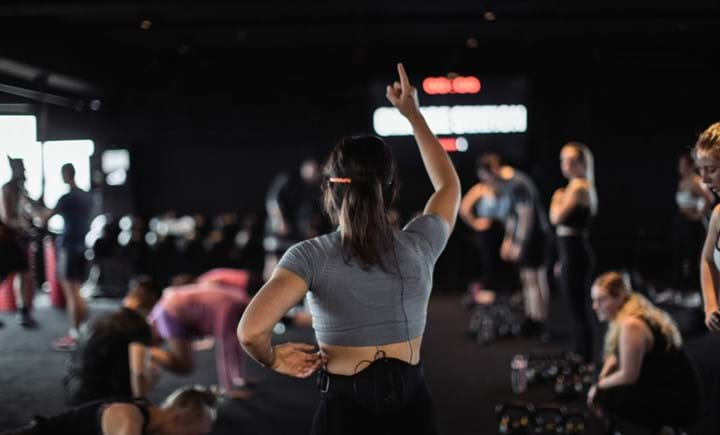
When fitness legend Natasha Vincent stepped into the role of GFM at Les Mills Auckland City – one of the world’s leading clubs for group training, running 370 classes per week – she was immediately tasked with reinventing the studio timetable to accommodate renovations to the gym floor. She reveals the key ingredients for creating a schedule that will maximize studio capacity and create renewed excitement around your timetable.

Hi Tash. What are the main considerations when changing the timetable?
Natasha Vincent (NV): Our big thing was: “How do we make sure this timetable stays really exciting, despite the disruptions that will be going on in the gym?” We wanted to ensure that group fitness stayed really energetic and alive, so that members still felt they were getting a great experience at the club.
We tried to keep the new timetable as close to the original one as possible. Given that there will already be disruptions to people’s schedules with the gym floor, we didn’t want to disrupt it further with a brand-new timetable. The idea was to do a soft change.
How did you decide which classes to keep?
NV: We didn’t touch any of the high-performing classes at all. We left them and then looked at the shoulder classes – those classes sitting either side of those top-performing slots. We looked at both the class numbers, as well as the variety of programs across the week. For example, if there’s BODYPUMP™ on at the same time every day, there’s a chance to swap out one of those classes for something else. A lot of members might only be able to attend the 6pm timeslot, so we want to make sure we’re offering them variety in their training. It’s looking at the timetable horizontally, rather than vertically, and making sure there are lots of options – i.e. what are we offering at 6pm every day of the week? Will that member get a good mix of training stimuli? We also have the two studios, so we try to ensure that if there’s a strength class on upstairs, there’s a cardio one downstairs or vice versa.
How many classes did you end up cutting?
NV: 17. Yeah, that’s a lot. That’s when we had to look at the numbers and make the tough call on what needs to go. We normally run 326 live classes per week and when you add Virtual to that, it’s about 370.
Even though we had to cut classes, we didn’t want to cut budget. We still had the money to pay Instructors, so as much as possible I made classes team-teaches, and paid both Instructors full rate. This meant we could keep our great Instructors engaged and not cut their income.
When it came to moving other classes around, we tried not to move them by more than 15 minutes, because we know that will really impact people’s schedules. For example, can we move this BODYATTACK™ class 10 minutes earlier and make it 45 minutes, so the BODYJAM™ class only has to start 15 minutes later? It’s like a little Tetris puzzle!

How do you ensure you're best looking after your members with the changes?
NV: We do know that attendance at the club might drop and for those who just come for the gym floor, they’ll probably go to another branch. We’ve allowed everyone access to all nearby Les Mills clubs to accommodate that. We also expect to see an uplift in group fitness attendance. We just hope the timetable can uphold that excitement and energy for the membership while we are undergoing renovations!
When you do decide to add a new program to the timetable, how do you decide where it should go?
NV: When we’re putting a new class on the timetable, they either need to go into a timeslot that doesn’t exist yet, or they replace another class. I’ll consider the class attendance numbers and the performance of programs overall when I make that decision. If we’re replacing an Instructor’s class with a new class, we always give them the opportunity to train in that program and hold onto the timeslot.
One of the challenges when implementing new programs is to make sure we don’t overload our existing Instructors and burn them out. Because we pilot a lot of new classes here, we often do need to get them onto the timetable pretty quickly. You can recruit personal trainers to teach programs like LES MILLS Strength Development™ but teaching group fitness is also a different skillset from training clients. It’s important to get the right people on stage so the program is delivered well.
You look after six studios and over 100 Instructors. What's been the biggest challenge of the role?
NV: Probably finding the best way to communicate with the team. When I looked after three studios it was easy – we had three chat groups and everyone just sorted their own covers – it was very easy to stay on top of everything. Now I have 100 Instructors – a broad range of ages and programs and not everyone is on Facebook. It’s been a challenge to find the communication method that suits everyone, because some people want emails, others want a text, and others only check Facebook Messenger. It’s finding the method that means everyone is included and stays up to date with what’s going on in-club. We took our time and after three months we decided the best way to go was to have Facebook Messenger groups for each program. But we didn’t rush into that decision.
The thing I was most nervous about was the reaction of the legendary Instructors that teach at this club – how they would respond to my being in charge. But everyone’s been great, really welcoming. I think the biggest thing was not to come in too fast and hot and make all these big sweeping changes. We’ve definitely taken our time and tried to be open about what the goals are, where we want to go, but also be really delicate with every decision we make.

What's the secret to managing a large team of Instructors?
NV: The biggest learning for me has been to be wary of falling into a space where Instructors start to think of you as their guidance counsellor. People can start coming to you with their personal problems – things happening outside of the gym – and it’s important to set a boundary so you don’t take on other people’s emotions too much. I need to have the attitude of: "Okay, what can I do to help you in the club with your classes?" You’ve got to be really careful where you draw the line, otherwise you can take on the emotions of your whole team.
The fact is that, while yes, I train and recruit Instructors, I don’t do that for the full 40 hours of the week. A big part of the role is working with all the other departments in the gym – reception, gym floor, membership consultants, etc... There's a huge admin side to the role – you’ve got to do the wages, the timetabling, and then you’re making the hard decisions of who gets to take a class or when to put a class on based off member feedback. There’s a lot of decision-making and action planning, and there are weeks where I don’t even have contact with my team.
When you have to take a class off the timetable, how do you handle the Instructor side of it?
NV: Group fitness is an emotional industry. Instructors do get really attached to their classes and it can be their way of connecting with others and how they get praise and recognition. It’s a big part of their identity. Taking a class away from someone is never easy because there’s so much emotional attachment associated with it. I might be thinking, it’s just a class, take it off, but that Instructor could be like, this is the one hour of the week where I feel good about myself. So that’s really difficult.
I always listen and try to understand where they’re coming from. And then I’ll bring it back to – how can I help you, but also help the club perform? The emotional side can be heavy, so it’s important to remind Instructors that if I have to take their class away it’s always a business decision – it’s not a personal attack on them.
WANT TO RAMP UP REVENUE FROM GROUP WORKOUTS?
Delve into our comprehensive array of tools and insights to help transform your studio into a profit powerhouse.
GET THE EDGE
